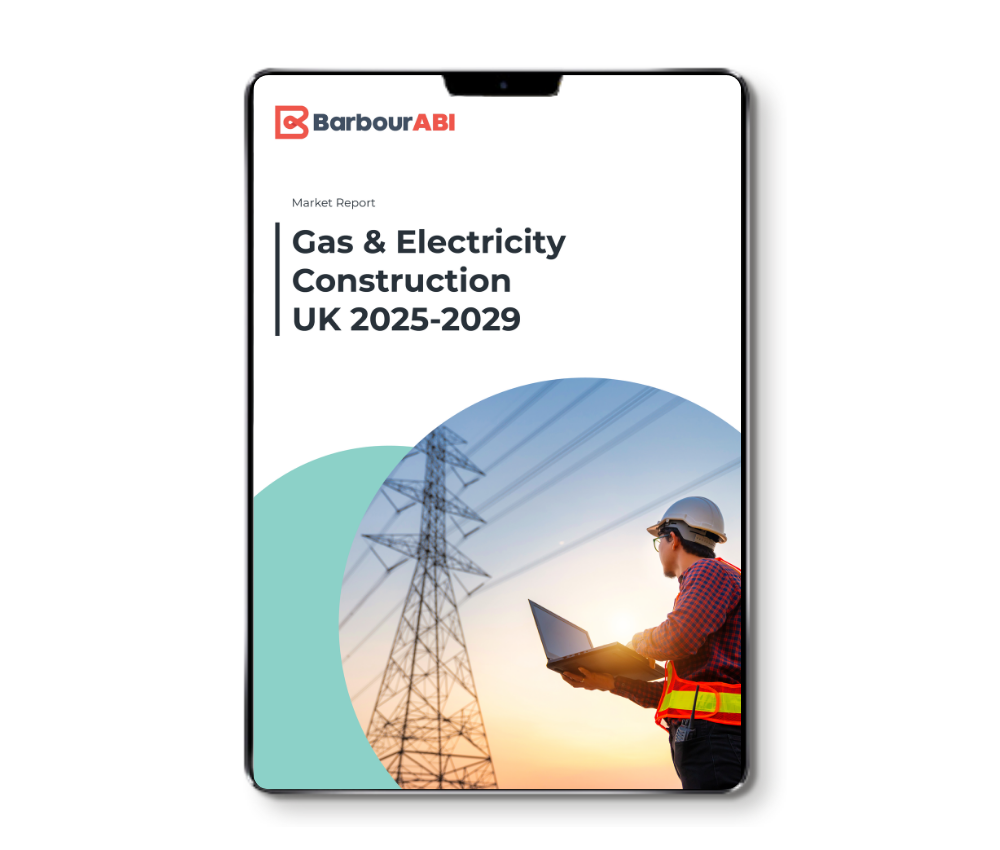The UK gas and electricity construction market is undergoing a significant transformation as we transition towards a cleaner energy future. This change is driven by ambitious government targets aimed at ensuring that at least 95% of electricity generation comes from low-carbon sources by 2030, along with policies designed to achieve net-zero carbon emissions by 2050.
Over the past decade, renewable energy generation has grown substantially, primarily driven by the expansion of wind and solar PV capacity. This progress has been a key success story in the UK’s decarbonisation efforts. In 2024, for the first time ever, more than half of the UK’s electricity was generated from renewable sources, with wind energy alone accounting for a record 29% of the total electricity generation.
Electricity construction sector set for double-digit annual growth
The electricity sector accounted for over a third (37%) of total infrastructure construction output in 2024, representing £12.5bn. In the first half of 2025, the sector accounted for a higher 42% of infrastructure output, at £7.4bn.
The electricity sector is expected to remain a key driver of infrastructure construction over the coming years, driven by the government’s decarbonisation agenda and the need to strengthen and expand the electricity grid to meet increasing demand and accommodate new renewables capacity. We anticipate sustained double-digit annual growth in this sector over the next few years.
Growth supported by transition to clean every and major grid upgrade
The government’s new Infrastructure Pipeline, launched in July 2025, outlines plans for approximately £530 billion in investments over the next decade, with energy representing the largest sector at 37%.
The strong pipeline aligns with the Clean Power 2030 Action Plan, which aims for 95% of electricity generation to come from low-carbon sources by 2030 and sets ambitious targets for onshore, offshore, and solar PV capacity.
A significant portion of the electricity infrastructure spending in the coming years will focus on reinforcing and expanding distribution and transmission networks. These upgrades are essential for transporting clean energy generated in locations, like out in the North Sea by wind turbines, to homes and businesses across England and Wales.
National Grid is undertaking 17 major infrastructure projects as part of its “Great Grid Upgrade” program, which includes new power lines, substations, and offshore cable links. National Grid has historically completed one major national transmission infrastructure project a year; thus, the planned 17 projects over the next few years represent a significant scale-up in capital investment.
Challenges Ahead
Despite the positive momentum, the market faces several challenges. High project costs, supply chain constraints, limited grid capacity, and permitting delays can hinder the timely delivery of essential infrastructure.
There is significant pressure on grid investment, which must keep pace with the rising demand for electricity and the expansion of renewable energy sources. Additionally, transitioning to a low-carbon energy system requires substantial investments in reskilling and upskilling initiatives.
To address these challenges, the government and regulators are implementing various reforms aimed at alleviating these constraints.
These reforms include streamlining the consenting process, offering incentives to invest in the supply chain and skills, improving funding mechanisms, reforming the grid connection process, and introducing strategic policies that create market certainty and foster innovation.
Opportunities
To capitalise on the opportunities presented by the energy transition, industry stakeholders should prioritise establishing long-term partnerships that enhance supply chain resilience and ensure the timely execution of ambitious infrastructure projects.
A sustained commitment from the government, along with a stable and supportive policy framework, will be essential to instil confidence in investors and developers. Additionally, encouraging collaboration among developers, regulators, and local communities will be vital for achieving clean power objectives.
“Electricity is expected to remain a key driver of infrastructure construction over the coming years. This growth will be fuelled by the government’s decarbonisation agenda, the need to strengthen and expand the electricity grid to meet rising demand, and the necessity for supply security. We anticipate sustained double-digit annual growth in this sector over the next few years.”
– Claudia Preedy, Author of the report.
Gas and Electricity Construction Market Report by Barbour ABI
The Gas and Electricity Construction Market Report includes topics such as trends influencing the market, market size and analysis, forecast, and key players operating in the UK.
Click below to view this report on our store website where you can see an exhaustive list of the table of contents, commentary, and more.


